中国组织工程研究 ›› 2019, Vol. 23 ›› Issue (36): 5850-5855.doi: 10.3969/j.issn.2095-4344.1944
• 骨与关节图像与影像 bone and joint imaging • 上一篇 下一篇
双侧椎弓根螺钉置入内固定联合椎间融合治疗腰椎间盘突出症:CT影像学的客观评估
郑淞文1,孟 仪2,龙钰函1,徐 哲1,张泳华1
- 大连市中心医院,1放射科,2脊柱外科,辽宁省大连市 116033
Bilateral pedicle screw fixation combined with interbody fusion for lumbar disc herniation: objective evaluation of CT imaging
Zheng Songwen1, Meng Yi2, Long Yuhan1, Xu Zhe1, Zhang Yonghua1
- 1Department of Radiology, 2Department of Spine Surgery, Dalian Central Hospital, Dalian 116033, Liaoning Province, China
摘要:
文章快速阅读:
.jpg)
文题释义:
腰椎间盘突出:是较为常见的疾患之一,主要是因为腰椎间盘各部分(髓核、纤维环及软骨板),尤其是髓核,有不同程度的退行性改变后,在外力因素的作用下,椎间盘的纤维环破裂,髓核组织从破裂之处突出(或脱出)于后方或椎管内,导致相邻脊神经根遭受刺激或压迫,从而产生腰部疼痛,一侧下肢或双下肢麻木、疼痛等一系列临床症状。腰椎间盘突出症以L4-5、L5-S1发病率最高,约占95%。
双侧椎弓根螺钉固定融合:被公认为处理各类脊柱疾病的标准方案,其具有生物力学及临床优势,双侧椎板关节突螺钉固定联合椎间融合器置入具有与双侧椎弓根螺钉固定联合椎间融合器置入相同的力学稳定性,增加脊柱的稳定性。
摘要
背景:对于合并有显著的腰椎不稳定的患者,需要通过外科手术将突出的椎间盘部分切除,同时扩大变窄的神经根管以缓解腰神经根的压迫,并且在切除突出椎间盘和扩大神经根管的同时还需要内固定联合植骨融合以恢复脊柱的稳定性,以解除不稳定因素所导致的腰神经根受压迫而产生的腰腿疼痛症状。有研究认为,CT检查可以准确的反映椎间盘是否发生突出,清楚显示椎间盘突出的形态、大小和部位。
目的:CT影像学评估双侧椎弓根螺钉置入内固定联合椎间融合治疗腰椎间盘突出症的临床疗效。
方法:回顾性分析2015年8月至2017年7月在大连市中心医院接受治疗的80例腰椎间盘突出症患者的病历资料。所有患者均接受双侧椎弓根螺钉置入内固定联合椎间融合治疗。研究于2018-06-30通过大连市中心医院伦理委员会审核批准。
结果与结论:①所有患者均顺利完成手术且完成随访;②治疗后1,3个月和末次随访的腰腿痛目测类比评分均显著低于治疗前(P < 0.05);③随着时间的延长,腰椎间盘突出患者治疗后MacNab疗效的优良率逐渐显著增加(P < 0.05);④治疗后各时间点的椎间盘腹侧高度、椎间盘背侧高度、椎间孔间最大高度、棘突顶距均显著性高于治疗前(P < 0.05);影像学显示治疗后患者的腰椎角度逐渐恢复,病变节段椎间隙高度恢复,CT扫描检查显示椎弓根螺钉固定良好,没有断裂和松动现象;治疗前及治疗后随访,CT影像检查的椎间盘腹侧高度、椎间盘背侧高度、椎间孔间最大高度、棘突顶距离与腰痛目测类比评分、腿痛目测类比评分之间均呈负相关(P < 0.05);⑤结果提示采用双侧椎弓根螺钉置入内固定联合椎体融合治疗腰椎间盘突出的临床疗效显著,使用CT影像学方法不但可以评估病情而且还可以评估椎间盘腹侧高度、椎间盘背侧高度、椎间孔间最大高度、棘突顶距恢复情况、腰椎角度恢复情况、螺钉置入的位置以及鉴别螺钉是否发生松动或断裂,评估临床疗效。
ORCID: 0000-0002-3450-3269(郑淞文)
中图分类号:
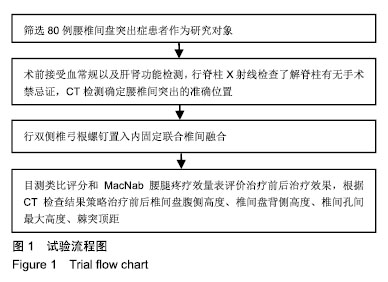
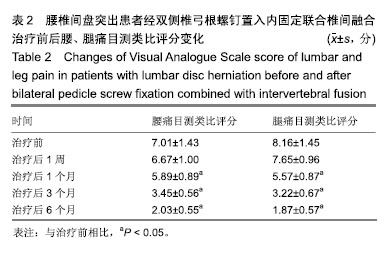
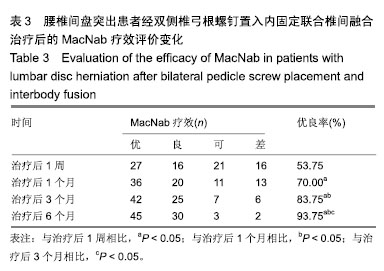
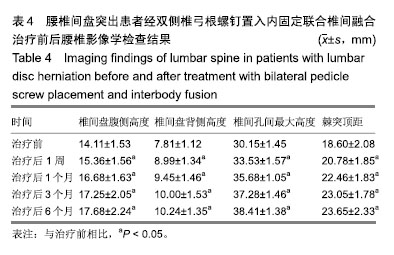
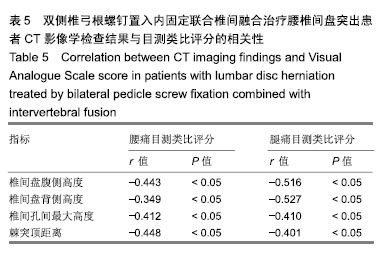
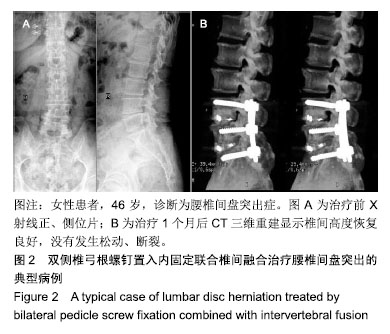
.jpg)
.jpg)